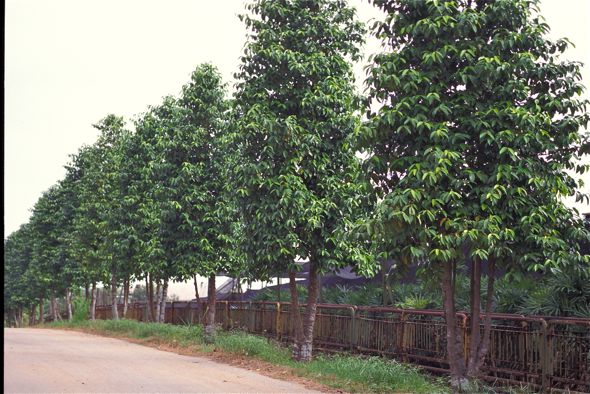Samson Tan documented a Black-naped Oriole (Oriolus chinensis) eating the “fruit” of the gymnosperm Gnetum gnemon LINK (above, below).
“One of my favourite snack is belinjau chips, I like it best to go with sambal chili (chili with prawn paste). Belinjau or some called it belinjo is from the tree Gnetum gnemon. Some birds like it too, such as Black Naped Oriole,” wrote Samson. He noted that the oriole handled the fruit the same way it handles insect prey, bashing it against the branch to displace the seed (below).
Also known as Spanish Joint Fir, the tree originated from the rainforests of Southeast Asia and as far north as Assam and eastward to Fiji. Only in Southeast Asia are these trees cultivated. In Singapore it is used as a roadside tree, as seen below along Lim Chu Kang.
Technically there are no flowers and fruits – being a member of the Gymnosperm. Instead, the tree bears cone-like structures. But these cones lack scales as seen in pines and araucarias. The male and female cones are borne on separate trees. The former bear whorls of minute “flowers” while the latter bear egg-shaped ovules (below). The so-called fruit consists of a simple seed enclosed within a pulpy ring that turns yellow, then orange-red.
The young leaves, “flowers” and “fruits” are eaten cooked as a vegetable. The kernel of the seed is flattened, then dried and fried into a crisp commonly known as emping or emping belinjau.
Samson Tan
Singapore
September 2013
Note: Images of belinjau by YC Wee


![OrioleBN-Gnetum [SamsonTan] - 2](https://besgroup.org/wp-content/uploads/OrioleBN-Gnetum-SamsonTan-2.jpg)
![OrioleBN-Gnetum [SamsonTan] - 5](https://besgroup.org/wp-content/uploads/OrioleBN-Gnetum-SamsonTan-5.jpg)
![OrioleBN-Gnetum [SamsonTan] - 3](https://besgroup.org/wp-content/uploads/OrioleBN-Gnetum-SamsonTan-3.jpg)








